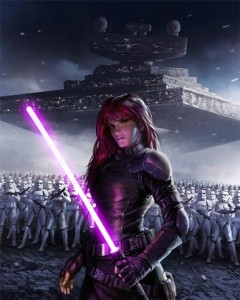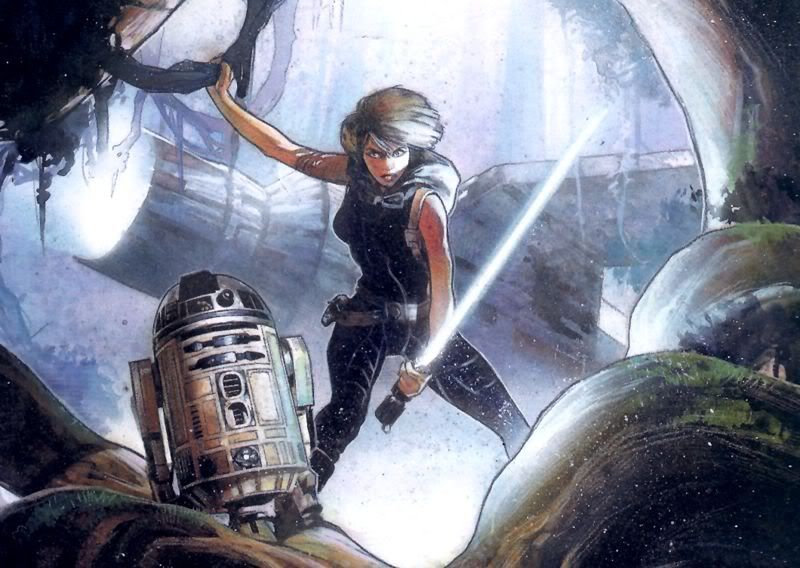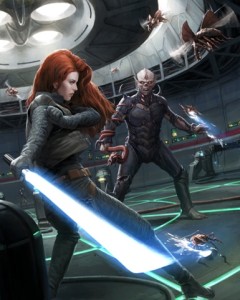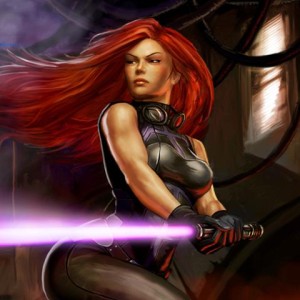Ever played a Star Wars video game and wondered how much of it was a “real” part of the Star Wars universe? Ever picked up a lunch box or a coloring book and thought to yourself whether or not this was part of the Star Wars mythos? For most people it’s unlikely, although for readers of this blog it’s a distinct possibility. Today we examine whether most everything with a Star Wars label on it should be part of the Star Wars continuity – or canon – or whether some products should exist just for the sake of fun and enjoyment, without complicating things unduly.
At the start, we’ll note that we’re not arguing for film purism. We’re not even arguing for snobbery that suggests a certain time period of Expanded Universe products was written better than others, which should be written out of the universe. In fact: we submit that the widely varied, inclusive, and richly textured Star Wars canon is what gives the Star Wars universe its scale, life, and energy. Instead, we want to focus our analysis on two specific recent Star Wars endeavors: The Force Unleashed video game and the Star Tours: The Adventures Continue attraction at the Disney theme parks. The question is: should these be an official part of the Star Wars canon, or can a ride be a ride and a game be a game sometimes?
**********Needless to say, this essay will contain spoilers for both the video game and the amusement park attraction**************
Canon – why all the sound and fury?
Canon – the term is redolent of literary and religious prestige. The canon, according to the Greeks and the Romans, was the body of literary work that was held in the highest esteem by the great and the learned: what we might today call classics or great works. To religious authorities, the canon is the list of books that can be deemed authoritative within religious dogma, and canon law is therefore the law set down by the Church since late antiquity. Both definitions derive from the original Greek word κανων, which was basically their word for a “yardstick” – later, a standard by which to judge other things.
Fictional franchises, including Star Wars, have adapted this usage: a canon work is a work within a franchise that is part of the official storyline. It is often distinguished from apocrypha – another term with religious roots – which refers to works which may share the same fictitious universe, but are not part of the official storyline or world that the creators have constructed. For the longest time, Star Wars fans debated whether anything that wasn’t a Star Wars film could ever be part of the authentic, canonical Star Wars saga. Debate raged on among the fans, who clung to off-hand remarks and scattered quotes from George Lucas and Lucasfilm representatives over the difference between “canonical” and “licensed,” “official” or “alternate universe.” Eventually Lucasfilm Licensing settled the issue, creating a tiered system for canon. The system, as it stands today, refers to the highest level of filmic canon as G-canon, The Clone Wars television show as T-canon, the Expanded Universe of books, guides, and games as C-canon, obscure and sometimes contradictory material that might gain canon status by reference in other works as S-canon, and works that aren’t canon at all are called N-canon (or by a prior name, Infinities).
So why this complex scheme? Well, it’s a concession to the idea that the Lucas-created world has primacy and that spin-off materials might sometimes conflict with it (though usually it’s the other way around, such as when the Prequel films contradicted some of the material established in the older EU). This canonical hierarchy resolved the problem by declaring that EU materials would be displaced by television or filmic materials, although continuity-minded folk will tell you that a hierarchy only solves part of the problem: trying to reduce the damage to the EU continuity by mitigating and massaging potential conflicts through retroactive continuity adjustments is an on-going process.
Moreover, the canon hierarchy does not really solve the problem of conflicts within the Expanded Universe C-canon category. The general rule of thumb is that almost everything is C-canon unless stated otherwise as a higher level of canon, and more recent C-canon sources trump older ones. Here’s where the problem arises. We could have an entire discussion on whether it’s a bad idea to have the most recent source trump older ones, especially as a strict chronological assessment takes no account of quality. But today, we’ll be focusing on the all-inclusive nature of C-canon instead.
The Force Unleashed
The Force Unleashed – hereinafter “TFU” – was a video game with an accompanying multimedia blitz of books, action figures, and RPG materials that resembled the great Shadows of the Empire (“SotE”) project of the late 90s. However, as far as continuity goes, the similarity ends there: where SotE carefully made use of existing continuity to expand and develop the universe, TFU ran roughshod over existing continuity and failed to make a good accounting of itself.
Let’s be specific: we’re talking about two issues. First is the over-powered nature of the main character, and second is the way that TFU changes the story about how the Rebellion was founded.
The main character in TFU is capable of astonishing feats of the Force, as per the game’s title and premise: to showcase Force usage beyond any limits we had previously conceived or witnessed. Consequently, Starkiller can not only blow his enemies away with gale-level Force bursts, crumple reinforced bulkheads as if they were tin soda cans, or wield enough lightning to embarrass both Thor and Zeus, Starkiller can also pull an Imperial Star Destroyer out of the sky while destroying its TIE Fighter escorts – all on his own! Oh, and he can outfight Darth Vader. No big deal.
Additionally, Starkiller – once Lord Vader’s secret apprentice – redeems himself and becomes a good guy because it’s thoroughly necessary for every Star Wars work to completely undermine the mythic saga of Vader’s redemption… whatever! As part of his redemption story, Starkiller inspires Bail Organa to formalize his opposition to the Empire and arranges for him to set up meetings with key resistance leaders to create a movement that will be known as the Rebel Alliance. Now, to the game’s credit, the story does make use of existing continuity on the Rebellion’s foundation by involving three Old Republic Senators – Bail Organa, Mon Mothma, and Garm bel Iblis, but it places Starkiller in the central role. Worse yet, it turns the signing of the Declaration of Rebellion into an Imperial ambush, after which none other than the Galactic Emperor himself – on board the Death Star! – personally beholds the new Rebel leaders. Why is this problematic? Because Bail Organa in particular continued to serve in the Senate, and because the EU had long since established that he was a secret backer of the Rebellion within the Imperial Senate, as contrasted with the rather public retirements of Mothma and bel Iblis.
This is not only an EU problem: it stretches credulity for Princess Leia Organa to be Alderaan’s senator, and shielded by diplomatic immunity if her father is a known traitor. Why did Lord Vader need a pretext to arrest her? Why was her father free to operate as he saw fit?
One last insult to injury: Starkiller’s family crest became the symbol of the Rebel Alliance. Might as well go all the way, we suppose.
There’s an easy solution to all of this: TFU is just a game. Treat it as such. Now, we can hear the cries of all the EU completionists already: they’ll point out that games are a valuable part of the EU canon and have made a lot of important contributions, in terms of storyline, ideas, and even integration of existing continuity. This is all true, and we do not argue that video games are intrinsically non-canon. Yet when the logic of a video game requires immense suspension of disbelief – such as when Empire at War had us believe that Princess Leia’s corvette at the beginning of A New Hope was escorted by a Rebel fleet as it fought with Lord Vader’s Star Destroyer (making one wonder if she thought Lord Vader was mentally compromised to believe her protestations of diplomatic innocence) – one should just say a game is a game.
The premise of TFU was to break boundaries and astonish the audience. It succeeded. But its very goal demands that it just be treated as an imaginative exercise rather than an existing and functional part of the Expanded Universe.
Star Tours: The Adventures Continue
In 1987, George Lucas and Industrial Light & Magic dusted off their old Star Wars models and created the first live-action Star Wars film experience since Return of the Jedi. It was an astonishing feat and it echoes all the rollicking good fun and excitement of the original Star Wars films. It remains this author’s favorite theme park attraction.
Yet the attraction – a short film projected onto a motion simulated space transport – had some continuity wrinkles too. Ostensibly, the Star Tours company operated Starspeeder 3000 transports – providing an amusing Star Wars-ified view of air travel, but in space, complete with airport humor – on tours to familiar locales from the original Star Wars films. The attraction itself featured the “Endor Express,” but the riders never arrive at the planet, instead experiencing a wild ride through ice comets, a close call with an Imperial Star Destroyer, a dog-fight among X-wings and TIE Fighters, and finally an honest-to-goodness Death Star trench run. But wait – which Death Star was this? It had a trench, but it’s at Endor – but it’s fully complete, too! Lucasfilm employees and Star Wars writers have as much fondness of the ride as this author does, so they took great pleasure in referring to a hypothetical Death Star III, effectively treating the ride as canon. Yet there was no pressing need for the ride to be C-canon: an author could express their fondess for the ride by referring to specific aspects of it, such as when Timothy Zahn referred to the “Starspeeder 3000” craft in his Thrawn trilogy of books in the early 90s. The ride could have been S-canon!
Star Tours was recently redone with modern simulators and a 3D, HD video track. Since the ride eventually became “stale” among park attendees over a period of two decades, the new version of the ride featured several alternate scenarios: the odds of any two ride experience being the same were now much smaller. The potential sequences span different worlds, from arboreal Kashyyyk to urban Coruscant. Though the ride is notionally a prequel to the original Star Tours – featuring Starspeeder 1000s – and consequently set between Revenge of the Sith and A New Hope (confirmed by video displays inside the ride waiting area itself), the Coruscant sequence features scenes right out of Episode III’s opening battle while the Hoth sequence features an Imperial attack on a Rebel base complete with AT-AT walkers. Even the Naboo sequence features a Trade Federation attack on the planet, even though the Naboo pilots offer to lead the Starspeeder to the planet’s “Rebel base,” where the passengers are inducted into the Rebel Alliance.
EU continuity buffs enjoy challenges of this nature: they enjoy coming up with convoluted explanations, such as a Clone Wars reenactment above the Imperial capital, or a pirate attack on Naboo using captured Trade Federation ships (admittedly it was enjoyable coming up with those). The question is, though, aside from an intellectual exercise: what do these fixes accomplish? What benefit do they provide to the larger Star Wars universe? Can’t a ride just be a ride?
Recently, Star Wars writer James McFadden published a blog article on the official Star Wars website chronicling, in-universe, the two incarnations of the Star Tours ride. He very deliberately avoided answering the question of whether or not the new Star Tours ride was canon in every aspect, although he did reveal in comments on TheForce.Net’s Literature forum that he favors treating the ride variations as snapshots into different Starspeeder journeys taken by Rebel spies at different chronological periods of the Galactic Civil War. This solution is probably the best solution offered: although we still wonder if perhaps a fun ride or a fun video came can be just that, without requiring so much extra effort just to squeeze it into continuity.
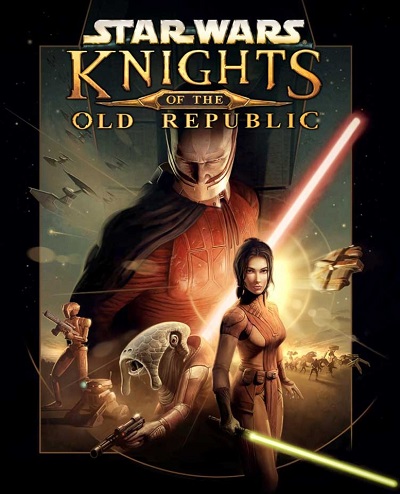 For starters, consider the Knights of the Old Republic video game. Not only is its popularity unrivaled among Expanded Universe stories, with the possible exception of the Thrawn trilogy, but the thing is a giant, hulking brick of story plopped right into the middle of what was previously a fairly empty span of time—it certainly owed a lot of groundwork to the Tales of the Jedi comics of the nineties, but I think few would argue that it didn’t run a good bit farther with the ball than Anderson and Veitch ever did.
For starters, consider the Knights of the Old Republic video game. Not only is its popularity unrivaled among Expanded Universe stories, with the possible exception of the Thrawn trilogy, but the thing is a giant, hulking brick of story plopped right into the middle of what was previously a fairly empty span of time—it certainly owed a lot of groundwork to the Tales of the Jedi comics of the nineties, but I think few would argue that it didn’t run a good bit farther with the ball than Anderson and Veitch ever did.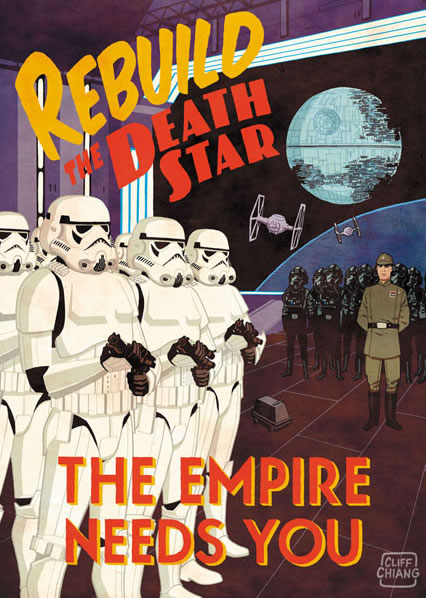
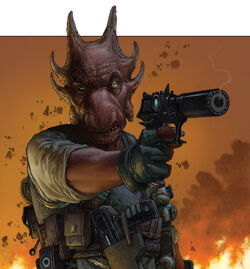 Perhaps better to ask what characters there are that are deemed as equal to the lead human characters? In this respect, it seems the best examples in recent years can be found in comics. Knights of the Old Republic alone gives us two very well-realized characters in the form of Jarael and Gryph, the latter of which has his own fanbase! Dark Times has Bomo and the crew of the Uhumele, all well-done characters. In both cases we don’t see either Zayne Carrick or Jass Dennir attempting to steamroller them into submission, although it isn’t in their character to do so. Stazi, already mentioned, tends to take center stage in any story he’s in and then there’s Jedi Master K’Krukh…
Perhaps better to ask what characters there are that are deemed as equal to the lead human characters? In this respect, it seems the best examples in recent years can be found in comics. Knights of the Old Republic alone gives us two very well-realized characters in the form of Jarael and Gryph, the latter of which has his own fanbase! Dark Times has Bomo and the crew of the Uhumele, all well-done characters. In both cases we don’t see either Zayne Carrick or Jass Dennir attempting to steamroller them into submission, although it isn’t in their character to do so. Stazi, already mentioned, tends to take center stage in any story he’s in and then there’s Jedi Master K’Krukh…
